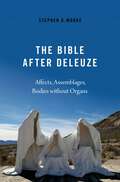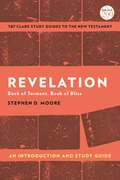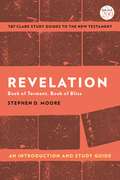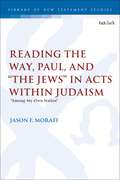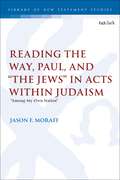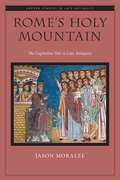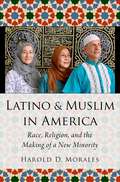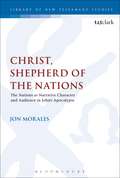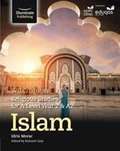- Table View
- List View
The Bible After Deleuze: Affects, Assemblages, Bodies Without Organs
by Stephen D. MooreThe impact of Gilles Deleuze on critical thought in the opening decades of the twenty-first century rivals that of Jacques Derrida or Michel Foucault on critical thought in the closing decades of the twentieth. The "Deleuze and..." industry is in overdrive in the humanities, the social sciences, and beyond, busily connecting Deleuzian philosophy to everything from literature to architecture, metaphysics to mathematics, ethics to physics, sexuality to technology, and ecology to theology. What of Deleuze and the Bible? What does the Bible become when it is plugged into the Deleuzian corpus? An immense affective assemblage, among other things. And what does biblical criticism become in the process? A practice of close reading that is other than interpretation and renounces the concept of representation. Not just for those already familiar with the work of Deleuze, the book begins with an extended introduction to Deleuzian thought. It then proceeds to unexegetical explorations of five successive themes: Text (how to make yourself a Bible without Organs, and why); Body (why there are no bodies in the Bible, and how to read them anyway); Sex (a thousand tiny sexes, a trillion tiny Jesuses); Race (Jesus and the white faciality machine); and Politics (democracy, despots, pandemics, ancient prophets). Cumulatively, these explorations limn the fluid contours of a Bible after Deleuze.
The Bible After Deleuze: Affects, Assemblages, Bodies Without Organs
by Stephen D. MooreThe impact of Gilles Deleuze on critical thought in the opening decades of the twenty-first century rivals that of Jacques Derrida or Michel Foucault on critical thought in the closing decades of the twentieth. The "Deleuze and..." industry is in overdrive in the humanities, the social sciences, and beyond, busily connecting Deleuzian philosophy to everything from literature to architecture, metaphysics to mathematics, ethics to physics, sexuality to technology, and ecology to theology. What of Deleuze and the Bible? What does the Bible become when it is plugged into the Deleuzian corpus? An immense affective assemblage, among other things. And what does biblical criticism become in the process? A practice of close reading that is other than interpretation and renounces the concept of representation. Not just for those already familiar with the work of Deleuze, the book begins with an extended introduction to Deleuzian thought. It then proceeds to unexegetical explorations of five successive themes: Text (how to make yourself a Bible without Organs, and why); Body (why there are no bodies in the Bible, and how to read them anyway); Sex (a thousand tiny sexes, a trillion tiny Jesuses); Race (Jesus and the white faciality machine); and Politics (democracy, despots, pandemics, ancient prophets). Cumulatively, these explorations limn the fluid contours of a Bible after Deleuze.
Revelation: Book of Torment, Book of Bliss (T&T Clark’s Study Guides to the New Testament)
by Stephen D. MooreThis study guide explores the origins and reception history of the Book of Revelation and its continuing fascination for readers from both religious and secular backgrounds. Stephen D. Moore examines the transcultural impact Revelation has had, both within and beyond Christianity, not only on imaginings of when and how the world will end, but also on imaginings of the risen Jesus, heaven and hell, Satan, the Antichrist, and even Mary the mother of Jesus.Moore traces Revelation's remarkable reception through the ages, with special emphasis on its twentieth and twenty-first century appropriations, before resituating the book in its original context of production: Who wroteit, where, when, why, and modelled on what? The study guide culminates with a miniature commentary on the entire text of Revelation, weaving together liberationist, postcolonial, feminist, womanist, queer, and ecological approaches to the book in order to discern what it might mean for contemporary readers and communities concerned with issues of social justice.
Revelation: Book of Torment, Book of Bliss (T&T Clark’s Study Guides to the New Testament)
by Stephen D. MooreThis study guide explores the origins and reception history of the Book of Revelation and its continuing fascination for readers from both religious and secular backgrounds. Stephen D. Moore examines the transcultural impact Revelation has had, both within and beyond Christianity, not only on imaginings of when and how the world will end, but also on imaginings of the risen Jesus, heaven and hell, Satan, the Antichrist, and even Mary the mother of Jesus.Moore traces Revelation's remarkable reception through the ages, with special emphasis on its twentieth and twenty-first century appropriations, before resituating the book in its original context of production: Who wroteit, where, when, why, and modelled on what? The study guide culminates with a miniature commentary on the entire text of Revelation, weaving together liberationist, postcolonial, feminist, womanist, queer, and ecological approaches to the book in order to discern what it might mean for contemporary readers and communities concerned with issues of social justice.
Introducing Feminist Perspectives on Pastoral Theology: Introducing Feminist Perspectives On Pastoral Theology (Introductions in Feminist Theology)
by Zoe Bennett MooreThis book introduces feminist perspectives in pastoral theology. It is concerned with both pastoral care and practice and also with pastoral theology and theory. It seeks to explore why the inclusion of women's experiences and of feminist perspectives is of vital importance to Christian pastoral practice and to a Christian understanding of God. It should be of interest to concerned practitioners and also has specifically in mind the needs of students of pastoral theology. It begins with the lived experience of violence in Church and society, moving through to the implications of this for our understanding of the human community and the divine.
Encounters with Vampires: Encounters With Vampires (Flash)
by Teresa MooreyThe books in this bite-sized new series contain no complicated techniques or tricky materials, making them ideal for the busy, the time-pressured or the merely curious. Encounters with Vampires is a short, simple and to-the-point guide to vampires. In just 96 pages, the reader will discover everything from Vlad the Impaler to Bella Swan and Edward Cullen. Ideal for the busy, the time-pressured or the merely curious, Encounters with Vampires is a quick, no-effort way to break into this fascinating topic.
Ambrose: Church and Society in the Late Roman World (The Medieval World)
by John MoorheadAn account, and assessment, of the career of St Ambrose (339-397), from 374 bishop of Milan and one of the four Doctors of the Christian Church (with Sts. Jerome, Augustine and Gregory the Great). A key figure in the transition of the later Roman Empire into its medieval successor, Western Christendom, Ambrose was deeply involved in the political, social and religious issues of his day: struggles between church and state (especially with Emperor Theodosius), the fight against heresy, but he also had a deep influence on Church thought such as the role and status of women. John Moorhead considers all these dimensions in a book that will be of compelling interest to historians of the Church and the late classical world and classical studies.
Ambrose: Church and Society in the Late Roman World (The Medieval World)
by John MoorheadAn account, and assessment, of the career of St Ambrose (339-397), from 374 bishop of Milan and one of the four Doctors of the Christian Church (with Sts. Jerome, Augustine and Gregory the Great). A key figure in the transition of the later Roman Empire into its medieval successor, Western Christendom, Ambrose was deeply involved in the political, social and religious issues of his day: struggles between church and state (especially with Emperor Theodosius), the fight against heresy, but he also had a deep influence on Church thought such as the role and status of women. John Moorhead considers all these dimensions in a book that will be of compelling interest to historians of the Church and the late classical world and classical studies.
Gregory the Great (The Early Church Fathers)
by John MoorheadGregory's life culminated in his holding the office of pope (590 - 604). He is generally regarded as one of the outstanding figures in the long line of popes, and by the late ninth century had come to be known as 'the Great'. Along with Ambrose, Jerome and Augustine, he played a critical role in the history of his time, while during the middle ages his intellectual influence was second only to that of Augustine.This volume provides a biographical and intellectual context to Gregory the Great, and new translations of his most influential writings.
Gregory the Great (The Early Church Fathers)
by John MoorheadGregory's life culminated in his holding the office of pope (590 - 604). He is generally regarded as one of the outstanding figures in the long line of popes, and by the late ninth century had come to be known as 'the Great'. Along with Ambrose, Jerome and Augustine, he played a critical role in the history of his time, while during the middle ages his intellectual influence was second only to that of Augustine.This volume provides a biographical and intellectual context to Gregory the Great, and new translations of his most influential writings.
What is a Madrasa? (Islamic Civilization And Muslim Networks Ser.)
by Ebrahim MoosaThe prospects for peace in Afghanistan, dialogue between Washington and Tehran, the UN’s bid to stabilise nuclear-armed Pakistan, understanding the largest Muslim minority in the world’s largest democracy in India, or the largest Muslim population in the world in Indonesia †“ all require some knowledge of the traditional religious sectors in these countries and of what connection traditional religious schooling has (or not) to their geopolitical situations. Moosa delves into the world of madrasa classrooms, scholars and texts, recounting the daily life and discipline of the inhabitants. He shows that madrasa are a living, changing entity, and the site of contestation between groups with varying agendas, goals and notions of modernity. Reading this unique and engaging introduction will provide readers with a clear grasp of the history, place and function of the madrasa in today’s Muslim world (religious, cultural and political). It will also investigate the ambiguity underlying the charge that the madrasa is at heart a geopolitical institution.
Iraq’s Last Jews: Stories of Daily Life, Upheaval, and Escape from Modern Babylon (Palgrave Studies in Oral History)
by T. Morad D. ShashaIraq's Last Jews is a collection of first-person accounts by Jews about their lives in Iraq's once-vibrant, 2500 year-old Jewish community and about the disappearance of that community in the middle of the 20th century. This book tells the story of this last generation of Iraqi Jews, who both reminisce about their birth country and describe the persecution that drove them out, the result of Nazi influences, growing Arab nationalism, and anger over the creation of the State of Israel.
Reading the Way, Paul, and “The Jews” in Acts within Judaism: “Among My Own Nation” (The Library of New Testament Studies)
by Dr. Jason F. MoraffJason F. Moraff challenges the contention that Acts' sharp rhetoric and portrayal of “the Jews” reflects anti-Judaism and supersessionism. He argues that, rather than constructing Christian identity in contrast to Judaism, Acts binds the Way, Paul, and “the Jews” together into a shared identity as Israel, and that together they embark on a journey of repentance with common Jewishness providing the foundation. Acts leverages Jewish kinship, language, cult, and custom to portray the Way, Paul, and “the Jews” as one family debating the direction of their ancestral tradition. Using a historically situated narrative approach, Moraff frames Acts' portrayal of the Way and Paul in relation to the Jewish people as participating in internecine conflict regarding the Jewish tradition-in-crisis, after the destruction of the temple. By exploring ancient ethnicity, Jewish identity and Lukan characterization, images of the Jews, the Way, and Paul, violence in Acts and the theme of blindness in Luke's gospel, the Pauline writings and Acts, Moraff stresses that Acts speaks from “among my own nation,” meaning “the Jews”, and makes it possible to understand Acts' critical characterization of “the Jews” within Second Temple Judaism.
Reading the Way, Paul, and “The Jews” in Acts within Judaism: “Among My Own Nation” (The Library of New Testament Studies)
by Dr. Jason F. MoraffJason F. Moraff challenges the contention that Acts' sharp rhetoric and portrayal of “the Jews” reflects anti-Judaism and supersessionism. He argues that, rather than constructing Christian identity in contrast to Judaism, Acts binds the Way, Paul, and “the Jews” together into a shared identity as Israel, and that together they embark on a journey of repentance with common Jewishness providing the foundation. Acts leverages Jewish kinship, language, cult, and custom to portray the Way, Paul, and “the Jews” as one family debating the direction of their ancestral tradition. Using a historically situated narrative approach, Moraff frames Acts' portrayal of the Way and Paul in relation to the Jewish people as participating in internecine conflict regarding the Jewish tradition-in-crisis, after the destruction of the temple. By exploring ancient ethnicity, Jewish identity and Lukan characterization, images of the Jews, the Way, and Paul, violence in Acts and the theme of blindness in Luke's gospel, the Pauline writings and Acts, Moraff stresses that Acts speaks from “among my own nation,” meaning “the Jews”, and makes it possible to understand Acts' critical characterization of “the Jews” within Second Temple Judaism.
Rome's Holy Mountain: The Capitoline Hill in Late Antiquity (Oxford Studies in Late Antiquity)
by Jason MoraleeRome's Capitoline Hill was the smallest of the Seven Hills of Rome. Yet in the long history of the Roman state it was the empire's holy mountain. The hill was the setting of many of Rome's most beloved stories, involving Aeneas, Romulus, Tarpeia, and Manlius. It also held significant monuments, including the Temple of Jupiter Optimus Maximus, a location that marked the spot where Jupiter made the hill his earthly home in the age before humanity. This is the first book that follows the history of the Capitoline Hill into late antiquity and the early middle ages, asking what happened to a holy mountain as the empire that deemed it thus became a Christian republic. This is not a history of the hill's tonnage of marble and gold bedecked monuments, but rather an investigation into how the hill was used, imagined, and known from the third to the seventh centuries CE. During this time, the imperial triumph and other processions to the top of the hill were no longer enacted. But the hill persisted as a densely populated urban zone and continued to supply a bridge to fragmented memories of an increasingly remote past through its toponyms. This book is also about a series of Christian engagements with the Capitoline Hill's different registers of memory, the transmission and dissection of anecdotes, and the invention of alternate understandings of the hill's role in Roman history. What lingered long after the state's disintegration in the fifth century were the hill's associations with the raw power of Rome's empire.
Rome's Holy Mountain: The Capitoline Hill in Late Antiquity (Oxford Studies in Late Antiquity)
by Jason MoraleeRome's Capitoline Hill was the smallest of the Seven Hills of Rome. Yet in the long history of the Roman state it was the empire's holy mountain. The hill was the setting of many of Rome's most beloved stories, involving Aeneas, Romulus, Tarpeia, and Manlius. It also held significant monuments, including the Temple of Jupiter Optimus Maximus, a location that marked the spot where Jupiter made the hill his earthly home in the age before humanity. This is the first book that follows the history of the Capitoline Hill into late antiquity and the early middle ages, asking what happened to a holy mountain as the empire that deemed it thus became a Christian republic. This is not a history of the hill's tonnage of marble and gold bedecked monuments, but rather an investigation into how the hill was used, imagined, and known from the third to the seventh centuries CE. During this time, the imperial triumph and other processions to the top of the hill were no longer enacted. But the hill persisted as a densely populated urban zone and continued to supply a bridge to fragmented memories of an increasingly remote past through its toponyms. This book is also about a series of Christian engagements with the Capitoline Hill's different registers of memory, the transmission and dissection of anecdotes, and the invention of alternate understandings of the hill's role in Roman history. What lingered long after the state's disintegration in the fifth century were the hill's associations with the raw power of Rome's empire.
Latino and Muslim in America: Race, Religion, and the Making of a New Minority (AAR Religion, Culture, and History)
by Harold D. MoralesLatino and Muslim in America examines how so-called "minority groups" are made, fragmented, and struggle for recognition. The U.S. is poised to become the first nation whose collective minorities outnumber the dominant population, and Latinos play no small role in this world-changing demographic shift. Even as many people view Latinos and Muslims as growing threats, Latino Muslims celebrate their intersecting identities in their daily lives and in their mediated representations. In this book, Harold D. Morales follows the lives of several Latino Muslim leaders from the 1970's to the present, tracing their efforts to organize and unify nationally in order to solidify the new identity group's place within the public sphere. Drawing on four years of media analysis, ethnographic and historical research, Morales demonstrates that Latinos embrace Islam within historically specific contexts that include distinctive immigration patterns and new laws, urban spaces, and media technologies that have increasingly brought Latinos and Muslims into contact. He positions this growing community as part of the mass exodus out of the Catholic Church, the growth of Islam, and the digitization of religion. Latino and Muslim in America explores the interactions between religion, race, and media to conclude that these three categories are inextricably entwined.
Latino and Muslim in America: Race, Religion, and the Making of a New Minority (AAR Religion, Culture, and History)
by Harold D. MoralesLatino and Muslim in America examines how so-called "minority groups" are made, fragmented, and struggle for recognition. The U.S. is poised to become the first nation whose collective minorities outnumber the dominant population, and Latinos play no small role in this world-changing demographic shift. Even as many people view Latinos and Muslims as growing threats, Latino Muslims celebrate their intersecting identities in their daily lives and in their mediated representations. In this book, Harold D. Morales follows the lives of several Latino Muslim leaders from the 1970's to the present, tracing their efforts to organize and unify nationally in order to solidify the new identity group's place within the public sphere. Drawing on four years of media analysis, ethnographic and historical research, Morales demonstrates that Latinos embrace Islam within historically specific contexts that include distinctive immigration patterns and new laws, urban spaces, and media technologies that have increasingly brought Latinos and Muslims into contact. He positions this growing community as part of the mass exodus out of the Catholic Church, the growth of Islam, and the digitization of religion. Latino and Muslim in America explores the interactions between religion, race, and media to conclude that these three categories are inextricably entwined.
Christ, Shepherd of the Nations: The Nations as Narrative Character and Audience in John's Apocalypse (The Library of New Testament Studies #577)
by Jon MoralesDoes John's Apocalypse envision destruction or salvation for the nations of the world? Scholarly views on this issue range from extreme (total destruction) to extreme (universal salvation). Jon Morales maintains that the question must be reframed to highlight, not only the destiny of the nations, but also their dilemma within the drama of world history. Using narrative methodology, Morales asks four key questions concerning the nations: What is John's story of the nations? How does he tell this story? What is John's message to the nations? And what is his message to the church concerning the nations? Literary characters cannot be understood in the abstract, but must be rather discovered sequentially in the development of an entire narrative. The nations in Revelation are no exception. Understanding that previous studies have neglected to situate the nations within Revelation's larger plot, or in interaction with other narrative characters, Morales concludes that John's purpose is to show that the nations belong to God. John achieves his purpose in part by deploying a novel metaphor, virtually unexplored until now – Christ, shepherd of the nations
Christ, Shepherd of the Nations: The Nations as Narrative Character and Audience in John's Apocalypse (The Library of New Testament Studies #577)
by Jon MoralesDoes John's Apocalypse envision destruction or salvation for the nations of the world? Scholarly views on this issue range from extreme (total destruction) to extreme (universal salvation). Jon Morales maintains that the question must be reframed to highlight, not only the destiny of the nations, but also their dilemma within the drama of world history. Using narrative methodology, Morales asks four key questions concerning the nations: What is John's story of the nations? How does he tell this story? What is John's message to the nations? And what is his message to the church concerning the nations? Literary characters cannot be understood in the abstract, but must be rather discovered sequentially in the development of an entire narrative. The nations in Revelation are no exception. Understanding that previous studies have neglected to situate the nations within Revelation's larger plot, or in interaction with other narrative characters, Morales concludes that John's purpose is to show that the nations belong to God. John achieves his purpose in part by deploying a novel metaphor, virtually unexplored until now – Christ, shepherd of the nations
Showing How: The Act of Teaching
by Gabriel MoranThis book is thoroughly original work on the meaning of teaching by one who has been widely credited with reshaping the field of religious education in the United States, and to have had a significant effect also in many other countries.Despite a steady flow of books that have "teaching" in the title, nearly all of them leave out most of the story. In Showing How, Gabriel Moran presents the full story of the act of teaching. Part 1 establishes a fundamental meaning for "to teach," examining why there exists a deep-seated fear that teaching is an immoral act. Professor Moran then grounds the meaning of "to teach in its most basic forms, moving from examples in the nonhuman world (what the mountain teaches the mountain climber) to communal and nonverbal forms of teaching among humans.Part 2 explores the languages of teaching and the diverse forms of speech appropriate to teaching; rhetorical forms, including storytelling and preaching; therapeutic languages; and religion'' preservation of these languages in ritualized settings, including confessing and mourning.Part 3 draws out the implications for education, the school, and the teaching of morality.Showing How addresses not only schoolteachers but parents, counselors, ministers, administrators, and everyone who can recognize teaching as a fundamental human act. By exposing the root meaning of teaching, the book represents a challenge to any proposals for educational reform.Gabriel Moran is Professor and Director of Religious Education in the Department of Culture and Communication, New York University. He is the author of sixteen books, including Uniqueness: Problem or Paradox in Jewish and Christian Traditions and A Grammar of Responsibility.
The Imperial Church: Catholic Founding Fathers and United States Empire (The United States in the World)
by Katherine D. MoranThrough a fascinating discussion of religion's role in the rhetoric of American civilizing empire, The Imperial Church undertakes an exploration of how Catholic mission histories served as a useful reference for Americans narrating US settler colonialism on the North American continent and seeking to extend military, political, and cultural power around the world. Katherine D. Moran traces historical celebrations of Catholic missionary histories in the upper Midwest, Southern California, and the US colonial Philippines to demonstrate the improbable centrality of the Catholic missions to ostensibly Protestant imperial endeavors.Moran shows that, as the United States built its continental and global dominion and an empire of production and commerce in the Gilded Age and Progressive Era, Protestant and Catholic Americans began to celebrate Catholic imperial pasts. She demonstrates that American Protestants joined their Catholic compatriots in speaking with admiration about historical Catholic missionaries: the Jesuit Jacques Marquette in the Midwest, the Franciscan Junípero Serra in Southern California, and the Spanish friars in the Philippines. Comparing them favorably to the Puritans, Pilgrims, and the American Revolutionary generation, commemorators drew these missionaries into a cross-confessional pantheon of US national and imperial founding fathers. In the process, they cast Catholic missionaries as gentle and effective agents of conquest, uplift, and economic growth, arguing that they could serve as both origins and models for an American civilizing empire.The Imperial Church connects Catholic history and the history of US empire by demonstrating that the religious dimensions of American imperial rhetoric have been as cross-confessional as the imperial nation itself.
Where’s Santa’s Reindeer?: A Festive Search and Find Book
by Paul Moran Gergely Forizs Adam Linley Jorge SantillanFrom the publishers of the bestselling Where’s the Unicorn? comes a festive adventure to knock your Christmas stockings off.There’s a week to go before Christmas Eve and Santa’s eight favourite reindeer are nowhere in sight! Santa can’t deliver all the presents in one night without his trusted herd to pull the sleigh, so he and his chief elf set off to find them. Help Santa chase the reindeer through 17 intricately illustrated seasonal scenes and bring them home to the North Pole in time to load up the sleigh. There are 8 cute reindeer, plus Santa and his elf, to find in each location and the answer pages at the back feature extra things to spot.Illustrated by the bestselling artist behind Where's the Unicorn? and Where's the Meerkat?, this fab-yule-lous search book is a must-have Christmas gift.
WJEC/Eduqas Religious Studies for A Level Year 2 & A2: Islam (PDF)
by Idris MorarThe aim of this skills-based book is to provide support for you to achieve success at A Level Religious Studies and build upon the success of the Year 1 and AS series.
WJEC/Eduqas Religious Studies for A Level Year 2 & A2 (PDF)
by Idris MorarWritten by an experienced teacher and author with an in-depth understanding of teaching, learning and assessment at Year 2 and A2 Level, this book has an engaging visual style and tone, which will support you through the course and help you prepare for your exams.
